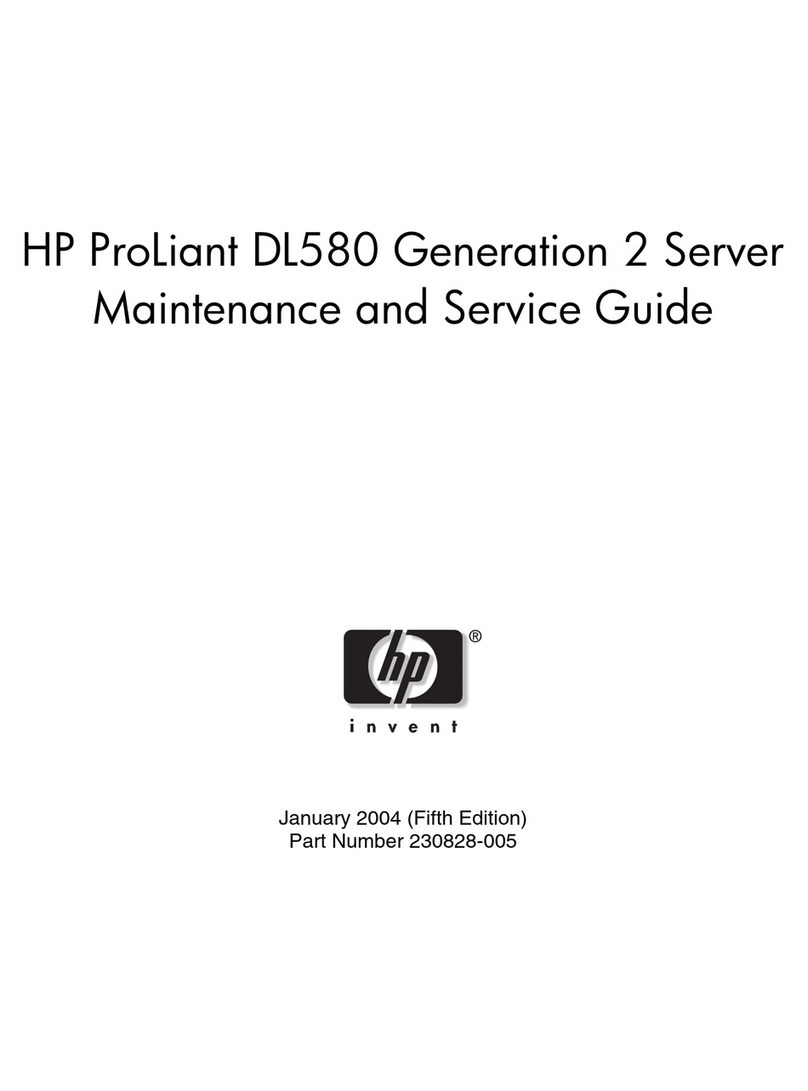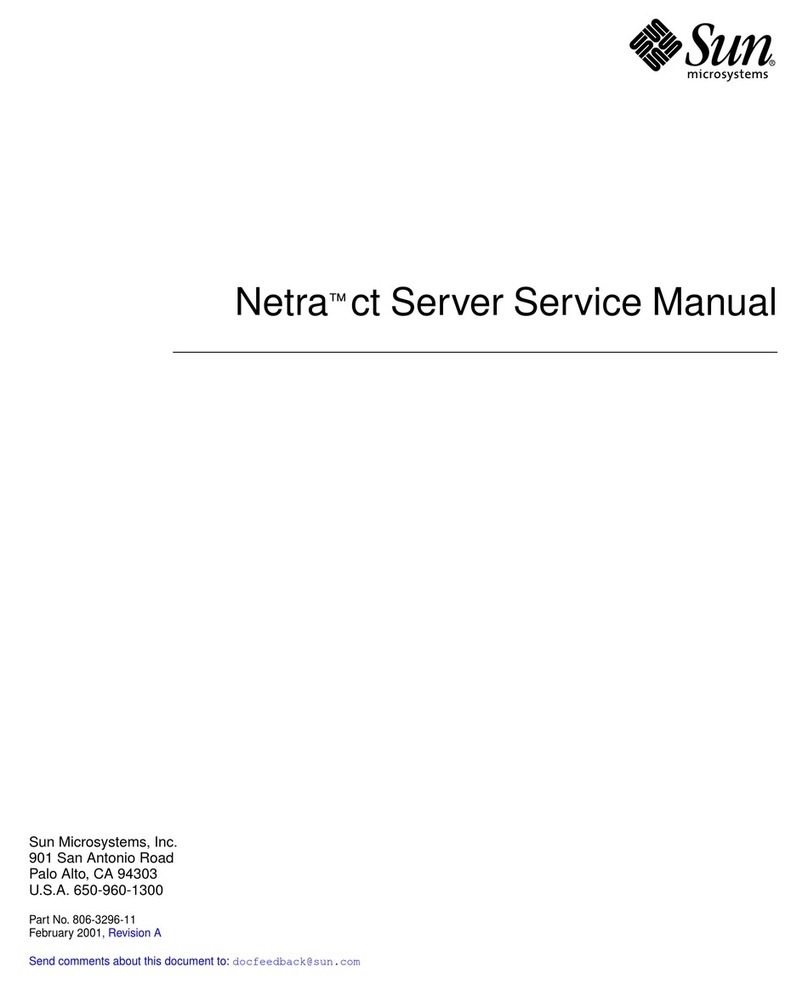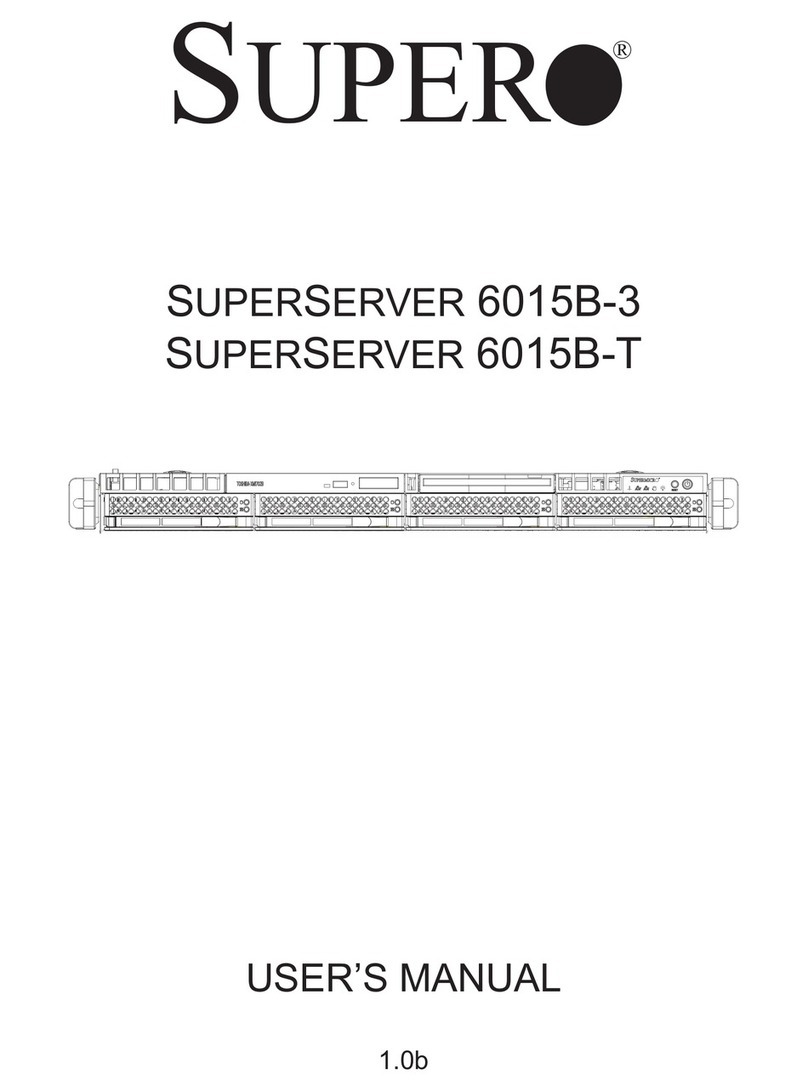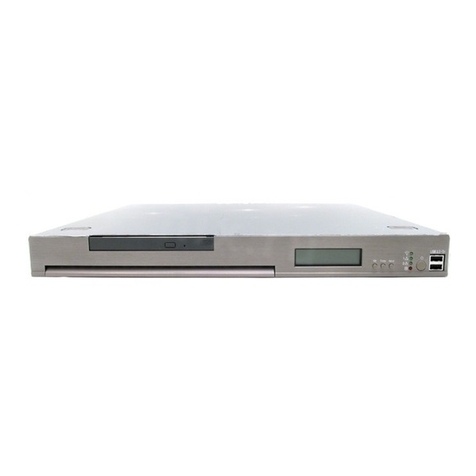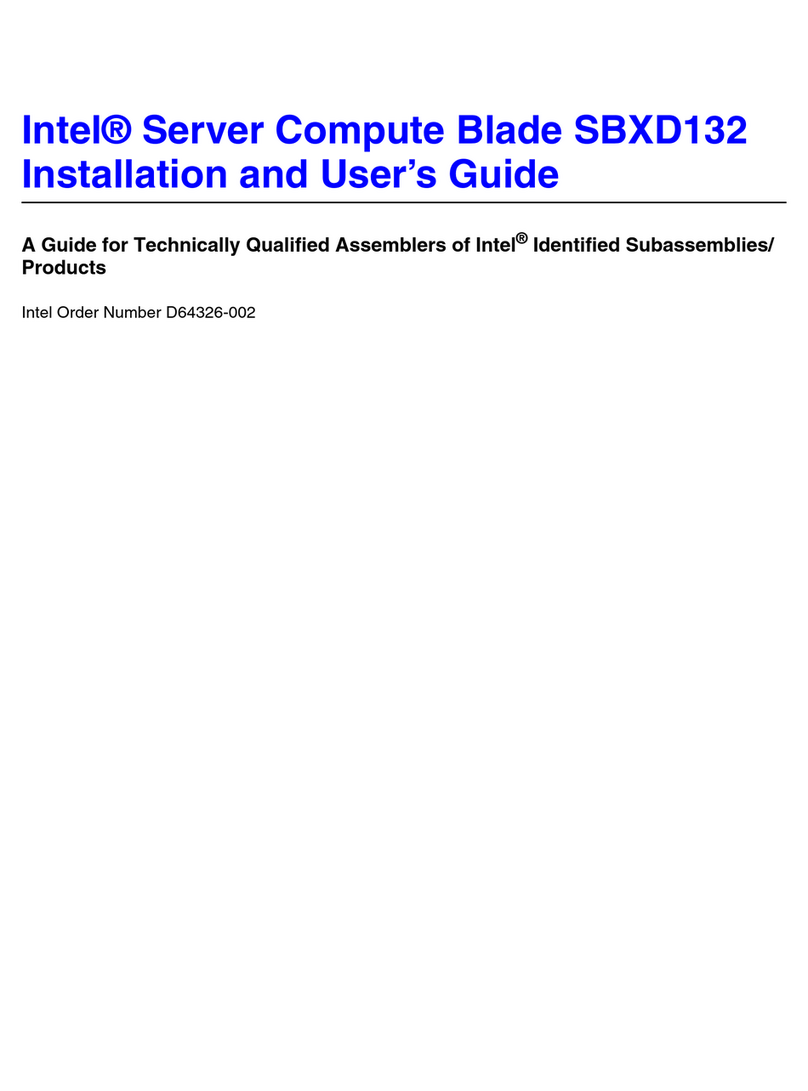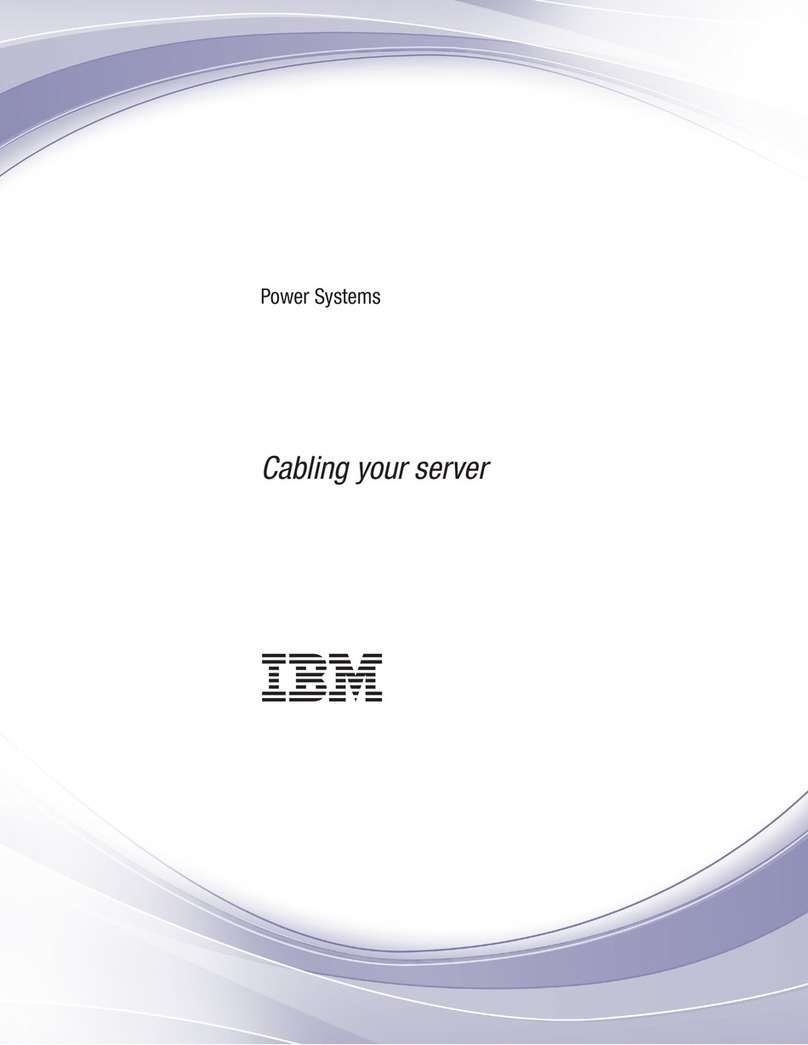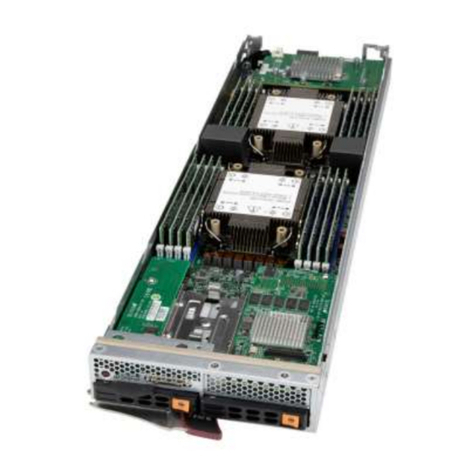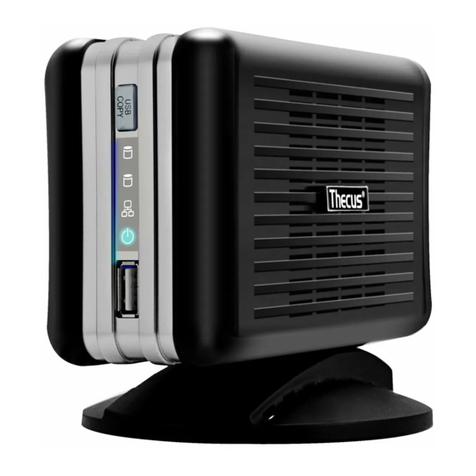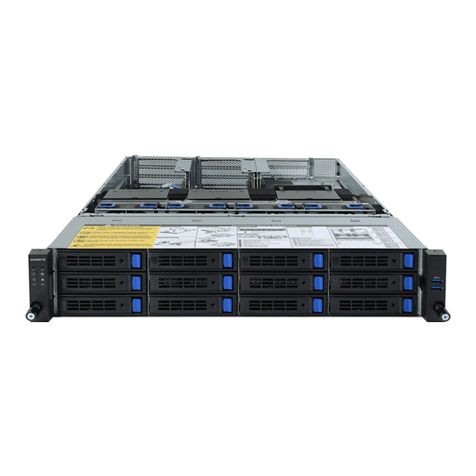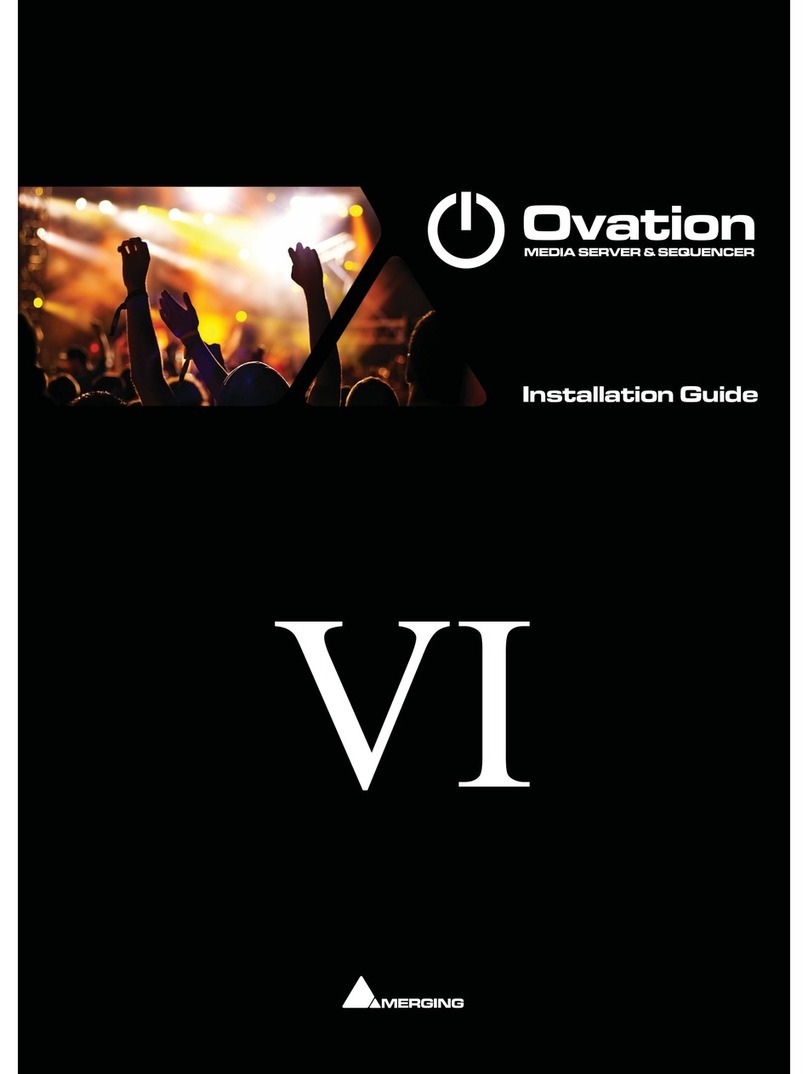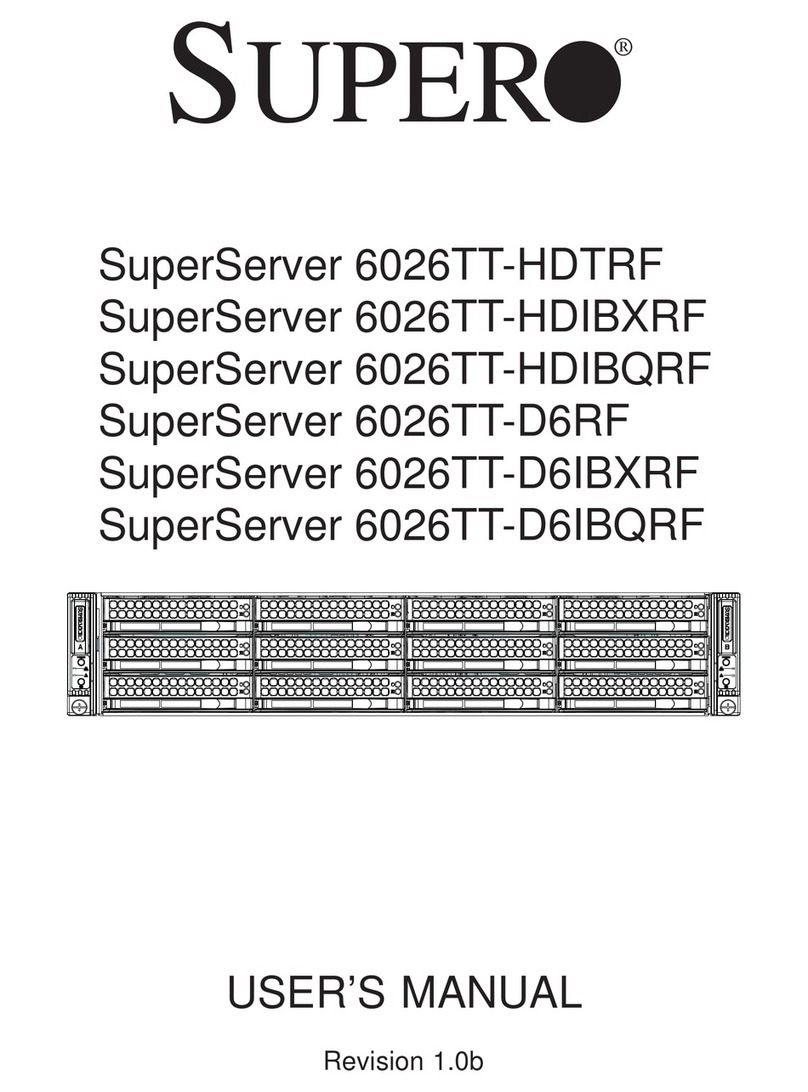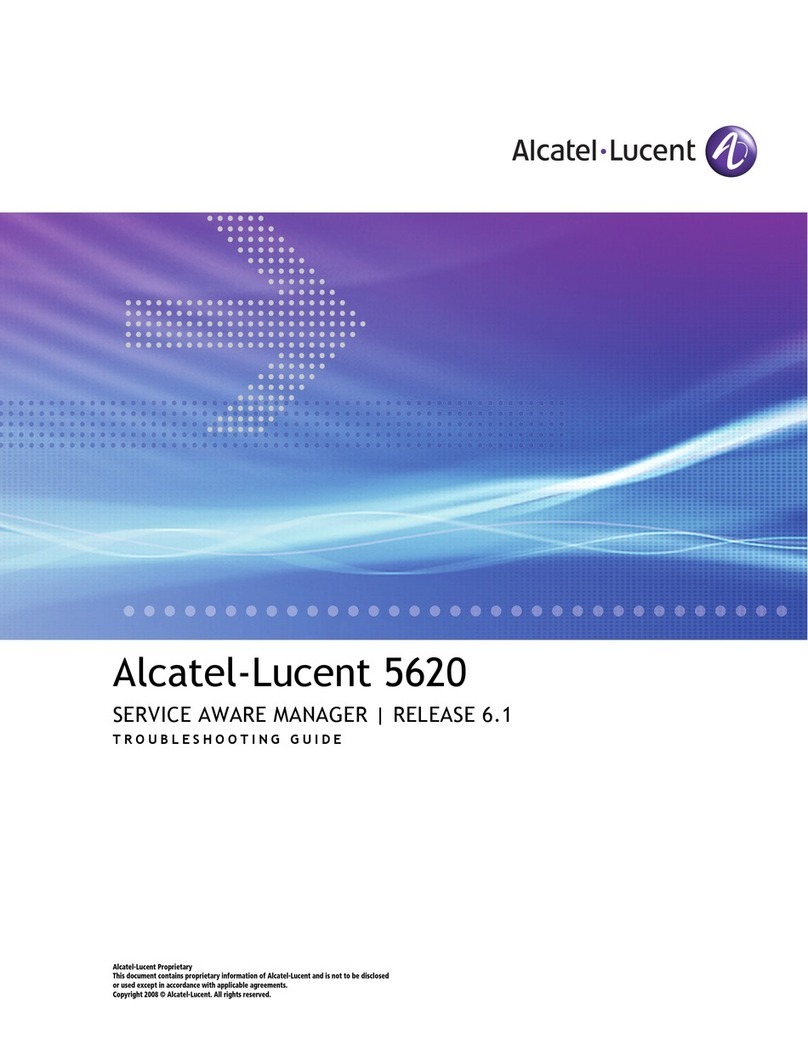FieldServer Fike Cheetah FS-8700-48 Release note

Driver Version:
1.1
Document Revision:
3
A Sierra Monitor Company
APPLICABILITY & EFFECTIVITY
Effective for all systems manufactured after September 2011
Driver Manual
(Supplement to the FieldServer Instruction Manual)
FS-8700-48 Fike Cheetah

FS-8700-48 Fike Cheetah Manual Table of Contents
FieldServer Technologies 1991 Tarob Court Milpitas, California 95035 USA Web: www.fieldserver.com
Tel: (408) 262 2299 Fax: (408) 262 2269 Toll Free: (888) 509 1970 email: support@fieldserver.com
TABLE OF CONTENTS
1Cheetah Device Description ...........................................................................................................................5
2Driver Scope of Supply ...................................................................................................................................5
2.1 Supplied by FieldServer Technologies for this driver.....................................................................................5
2.2 Provided by Supplier of 3rd Party Equipment.................................................................................................5
3Hardware Connections...................................................................................................................................6
3.1 Connection to Fike Cheetah Panel.................................................................................................................6
3.2 RS-485 Connection to Fike Cheetah Xi Panel.................................................................................................7
3.3 RS-232 Connection to Fike Cheetah Xi Panel.................................................................................................8
3.3.1 Connection Notes:..................................................................................................................................8
3.4 Connecting the FieldServer to the MIM (Multi-Interface Module) ...............................................................9
3.4.1 Connection Notes...................................................................................................................................9
4Data Array Parameters................................................................................................................................. 10
5Configuring the FieldServer as a Cheetah Device Client................................................................................ 11
5.1 Client Side Connection Parameters .............................................................................................................11
5.2 Client Side Node Parameters .......................................................................................................................12
5.3 Client Side Map Descriptor Parameters.......................................................................................................12
5.3.1 FieldServer Specific Map Descriptor Parameters .................................................................................12
5.3.2 Driver Specific Map Descriptor Parameters .........................................................................................13
5.4 Map Descriptor Examples............................................................................................................................14
5.4.1 Zone Status ..........................................................................................................................................14
5.4.2 Device Status........................................................................................................................................14
5.4.3 Panel Information ................................................................................................................................14
5.4.4 History Events ......................................................................................................................................14
5.4.5 Acknowledging Alarms ........................................................................................................................15
5.4.6 Map Descriptor Example 1. (All Zones Data) .......................................................................................16
5.4.7 Map Descriptor Example 2.(Specific Zone Data)..................................................................................16
5.4.8 Map Descriptor Example 3 –Zone Status as a numeric value .............................................................17
5.4.9 Map Descriptor Example 4 –All Devices..............................................................................................18
5.4.10 Map Descriptor Example 5 (Specific Device)........................................................................................19
5.4.11 Map Descriptor Example 6 - Device States as a Numeric Value ..........................................................19
5.4.12 Map Descriptor Example 7 –Panel Data .............................................................................................20
5.4.13 Map Descriptor Example 8 –History Data (All Devices) ......................................................................20
5.4.14 Map Descriptor Example 9 –Full History Event Record –Specific Device............................................21
5.4.15 Map Descriptor Example 10 –Full History Event Record –Any Device................................................21
5.4.16 Map Descriptor Example 11 –Alarm Ack.............................................................................................22
6Configuring the FieldServer as a Cheetah Device Server............................................................................... 23
Appendix A. Useful Features................................................................................................................................ 24
Appendix A.1. Acknowledging Alarms .....................................................................................................................24
Appendix B. Vendor Information ......................................................................................................................... 25
Appendix B.1. Fike Cheetah Panel Firmware version sensitivity .............................................................................25
Appendix B.1.1. Message 6.0 limitations .........................................................................................................25
Appendix B.1.2. Message 1.1 - Older firmware................................................................................................25

FS-8700-48 Fike Cheetah Manual Table of Contents
FieldServer Technologies 1991 Tarob Court Milpitas, California 95035 USA Web: www.fieldserver.com
Tel: (408) 262 2299 Fax: (408) 262 2269 Toll Free: (888) 509 1970 email: support@fieldserver.com
Appendix B.1.3. Message 1.1 - Newer Firmware .............................................................................................25
Appendix B.2. Fike XI Panel Limitations and capabilities.........................................................................................25
Appendix C. Troubleshooting............................................................................................................................... 26
Appendix C.1. Driver Error Messages ......................................................................................................................26
Appendix C.2. Driver Stats .......................................................................................................................................28
Appendix C.3. Map Descriptor Specific Errors.........................................................................................................28
Appendix C.4. Multiple Cheetah Panels ..................................................................................................................28
Appendix D. Reference ........................................................................................................................................ 29
Appendix D.1. Driver Scope .....................................................................................................................................29
Appendix D.2. Panel Firmware Versions..................................................................................................................29
Appendix D.3. Storing Panel Data............................................................................................................................29
Appendix D.4. How History Events are Stored ........................................................................................................30

FS-8700-48 Fike Cheetah Manual Page 5 of 36
FieldServer Technologies 1991 Tarob Court Milpitas, California 95035 USA Web: www.fieldserver.com
Tel: (408) 262 2299 Fax: (408) 262 2269 Toll Free: (888) 509 1970 email: support@fieldserver.com
1CHEETAH DEVICE DESCRIPTION
The Cheetah Protocol driver allows the FieldServer to transfer data to and from devices over either RS-232 or RS-
485 using the Cheetah device protocols (Legacy Cheetah Classic and the current Cheetah Xi).
The driver supports messages sent from the Cybercat panel. Specifically, the driver supports message 1.02 which
reports panel, zone and device states.
The FieldServer can emulate either a Server or Client but it should be noted that it can only process unsolicited
messages from the Cheetah devices. Thus, it does not provide an active Client driver. It is best to consider this
driver as a consumer only driver with the data being produced by a Cheetah controller.
2DRIVER SCOPE OF SUPPLY
2.1 Supplied by FieldServer Technologies for this driver
FieldServer Technologies PART #
Description
21723-1
Flat 6 way cable (7 foot) for RJ11 connection
FS-8915-10
UTP cable (7 foot) for RS-232 use
FS-8917-04
RJ45 to DB25F connector adapter
FS-8917-14
RJ11 to DB25M connection adapter
2.2 Provided by Supplier of 3rd Party Equipment
Part #
Description
Fike Cheetah panel and power supply.
RS-485 cable, if required.
Longer UTP cable, if required.

FS-8700-48 Fike Cheetah Manual Page 6 of 36
FieldServer Technologies 1991 Tarob Court Milpitas, California 95035 USA Web: www.fieldserver.com
Tel: (408) 262 2299 Fax: (408) 262 2269 Toll Free: (888) 509 1970 email: support@fieldserver.com
3HARDWARE CONNECTIONS1
The FieldServer is connected to the Cheetah panel's Peripheral Port (see below).
This port is either a serial port (identified as jack 4) or RS-485 port (use the terminals adjacent to jack 4).
Configure the Cheetah Panel according to manufacturer’s instructions
3.1 Connection to Fike Cheetah Panel
8917-14
MODEL
5000
SENTRY
RJ11
CONNECTOR
PART # 21797
FIKE CHEETAH
CONNECTOR
PART # 23048
FIKE CHEETAH PANEL
J4
FieldServer P1
18 RS-232 Port
GND
-
+
GND
-
+
FG
R1R2
RS-232
RS-485
1The connection diagrams are for Non Cybercat Panels. Connection info was not available at the time this document was last updated.

FS-8700-48 Fike Cheetah Manual Page 7 of 36
FieldServer Technologies 1991 Tarob Court Milpitas, California 95035 USA Web: www.fieldserver.com
Tel: (408) 262 2299 Fax: (408) 262 2269 Toll Free: (888) 509 1970 email: support@fieldserver.com
3.2 RS-485 Connection to Fike Cheetah Xi Panel
+ -
SHIELD
+ -
DACT 485 peripherals P6
Part of Cheetah XI panel
Twisted pair
+ +
to
- -
to
Connect
+
-
FieldServer
No Connection
SHIELD
To other Devices
*
*For FieldServer RJ45 Ports
Use RJ45 Pin1 for +
Use RJ45 Pin8 for -

FS-8700-48 Fike Cheetah Manual Page 8 of 36
FieldServer Technologies 1991 Tarob Court Milpitas, California 95035 USA Web: www.fieldserver.com
Tel: (408) 262 2299 Fax: (408) 262 2269 Toll Free: (888) 509 1970 email: support@fieldserver.com
3.3 RS-232 Connection to Fike Cheetah Xi Panel
RJ45 Connector
CHEETAH XI
PANEL
Terminal
Block
FS-8917-16
P5
RJ45
FieldServer
Tx
Rx
Gnd
Rx
Tx
Gnd
4
2
1
P5
Cheetah XI
8
1
4
Pinouts
FieldServer P1
18 RS-232 Port
3.3.1 Connection Notes:
Communication on the RS-232 port is untested.
We recommend that a RS-232 optical isolator is used on the connection between the FieldServer and the
Cheetah XI panel to isolate any potential ground differential issues.

FS-8700-48 Fike Cheetah Manual Page 9 of 36
FieldServer Technologies 1991 Tarob Court Milpitas, California 95035 USA Web: www.fieldserver.com
Tel: (408) 262 2299 Fax: (408) 262 2269 Toll Free: (888) 509 1970 email: support@fieldserver.com
3.4 Connecting the FieldServer to the MIM (Multi-Interface Module)
The RS-232 port of the FieldServer connects to the P5 (RJ11) RS-232 port of the MIM board.
3.4.1 Connection Notes
The Peripherals menu of the Fike Panel needs to be updated:
Hit ‘ESC’ until “Top Level Menu” is on the screen
Hit ‘F1’ for “Config”
Hit ‘F6’ for “Menu 2”
Hit ‘F6’ for “Menu 3”
Hit ‘F1’ for “Periph”
Hit ‘F1’ for “Device”
Choose address of MIM
Set “Type” to “Computer”
Set “Supervise” to “No”

FS-8700-48 Fike Cheetah Manual Page 10 of 36
FieldServer Technologies 1991 Tarob Court Milpitas, California 95035 USA Web: www.fieldserver.com
Tel: (408) 262 2299 Fax: (408) 262 2269 Toll Free: (888) 509 1970 email: support@fieldserver.com
4DATA ARRAY PARAMETERS
Data Arrays are “protocol neutral” data buffers for storage of data to be passed between protocols. It is necessary
to declare the data format of each of the Data Arrays to facilitate correct storage of the relevant data.
Section Title
Data_Arrays
Column Title
Function
Legal Values
Data_Array_Name
Provide name for Data Array
Up to 15 alphanumeric characters
Data_Array_Format
Provide data format. Each Data Array can only
take on one format. The Cheetah driver always
sets Data Array elements to a zero or one. Thus,
the use of bit arrays is suggested but is not
mandatory.
Float, BIT, UInt16, SInt16, Byte.
Data_Array_Length
Number of Data Objects. Must be larger than
the data storage area required by the Map
Descriptors for the data being placed in this
array.
1-10,000. If you use the 'All' keyword
when setting the parameter
Cheet_Zone/Device then the minimum
length is 128.
Example
// Data Arrays
Data_Arrays
Data_Array_Name
, Data_Array_Format
, Data_Array_Length
ZONE_ALARMS
, Bit
, 256
PANEL_DATA
, Float
, 1000
DA_HIST
, Float
, 1000
DEVICE_L1_STATE
, Float
, 256

FS-8700-48 Fike Cheetah Manual Page 11 of 36
FieldServer Technologies 1991 Tarob Court Milpitas, California 95035 USA Web: www.fieldserver.com
Tel: (408) 262 2299 Fax: (408) 262 2269 Toll Free: (888) 509 1970 email: support@fieldserver.com
5CONFIGURING THE FIELDSERVER AS A CHEETAH DEVICE CLIENT
For a detailed discussion on FieldServer configuration, please refer to the FieldServer configuration manual. The
information that follows describes how to expand upon the factory defaults provided in the configuration files
included with the FieldServer. (See “.csv” sample files provided with the FieldServer)
This section documents and describes the parameters necessary for configuring the FieldServer to communicate
with a Cheetah Device Client.
The configuration file tells the FieldServer about its interfaces, and the routing of data required. In order to enable
the FieldServer for Cheetah Device communications, the driver independent FieldServer buffers need to be
declared in the “Data Arrays” section, the destination device addresses need to be declared in the “Server Side
Nodes” section and the data required from the Client needs to be mapped in the “Server Side Map Descriptors”
section. Details on how to do this can be found below.
Note that in the tables, * indicates an optional parameter, with the bold legal value being the default.
5.1 Client Side Connection Parameters
Section Title
Connections
Column
Title
Function
Legal Values
Port
Specify which port the device is
connected to the FieldServer
P1-P8, R1-R22
Baud*
Specify baud rate
9600 (Vendor limitation)
Parity*
Specify parity
None, (Vendor limitation)
Data_Bits*
Specify data bits
8(Vendor limitation)
Stop_Bits*
Specify stop bits
1(Vendor limitation)
Protocol
Specify protocol used
Cheetah (makes the port the exclusive domain of Cheetah
devices.) This keyword is not required when specifying the
port.
Example
// Client Side Connections
Port
, Baud
, Protocol
, Parity
, Data_Bits
, Stop_Bits
P1
, 9600
, Cheetah
, None
, 8
, 1
2Not all ports shown are necessarily supported by the hardware. Consult the appropriate Instruction manual for details of the ports available
on specific hardware.

FS-8700-48 Fike Cheetah Manual Page 12 of 36
FieldServer Technologies 1991 Tarob Court Milpitas, California 95035 USA Web: www.fieldserver.com
Tel: (408) 262 2299 Fax: (408) 262 2269 Toll Free: (888) 509 1970 email: support@fieldserver.com
5.2 Client Side Node Parameters
Section Title
Nodes
Column Title
Function
Legal Values
Node_Name
Provide name for node
Up to 32 alphanumeric characters
Protocol
Specify protocol used
Cheetah
Port
Specify which port the device is connected to the
FieldServer
P1-P8, R1-R23
PLC_Type*
This parameter tells the driver what type of panel
you are connecting to. If not specified, the driver
expects a legacy Cheetah panel.
Cybercat , Cheetah
Example
// Client Side Nodes
Nodes
Node_Name
, Protocol
, Port
, PLC_Type
Cheet_Master1
, Cheetah
, P1
, Cheetah
5.3 Client Side Map Descriptor Parameters
5.3.1 FieldServer Specific Map Descriptor Parameters
Column Title
Function
Legal Values
Map_Descriptor_Name
Name of this Map Descriptor
Up to 32 alphanumeric characters
Data_Array_Name
Name of Data Array where data is to be
stored in the FieldServer
One of the Data Array names from
Section 4.
Data_Array_Offset
Starting location in Data Array
0 to (Data_Array_Length-1) as specified
in Section 4.
Function
Function of Client Map Descriptor
Passive
Node_Name
Provide name for Node
Up to 32 alphanumeric characters
3Not all ports shown are necessarily supported by the hardware. Consult the appropriate Instruction manual for details of the ports available
on specific hardware.
Set PLC_Type to Cybercat
for Xi Panels

FS-8700-48 Fike Cheetah Manual Page 13 of 36
FieldServer Technologies 1991 Tarob Court Milpitas, California 95035 USA Web: www.fieldserver.com
Tel: (408) 262 2299 Fax: (408) 262 2269 Toll Free: (888) 509 1970 email: support@fieldserver.com
5.3.2 Driver Specific Map Descriptor Parameters
Column Title
Function
Legal Values
Cheet_Zone*
A Map Descriptor may be used to store data for one, all or no
zones. To store data from multiple zones, multiple Map
Descriptors must be declared, each specifying the zone of
interest. When specifying “All”, the data for zone 0 is stored in
the first element of the Data Array defined by the
Data_Array_Name & Data_Array_Offset and the data for zone
127 in the 128th element of the Data Array.
Depending on the firmware version of the Cheetah panel some or
all of the following states are available. Abort, Trouble,
Supervisory, Zone Disable, Pre-Alarm, Alarm, Pre-Discharge,
Release, Process.
To store data for multiple states, multiple Map Descriptors must
be declared - One per state of interest.
None, All, 0-127
Must be None when
Cheet_Device is not equal
to None.
Cheet_Device*
Define one or more Map Descriptors to store data from the 0-127
addressable devices. Each Map Descriptor must have the
Cheet_Zone set to None.
Devices belong to one of 4 possible loops. Thus when
Cheet_Device is set to All or to a specific device number, the
Cheet_Loop number must be set to a value from 1 to 4.
If Cheet_Device is set to All then 128 states are stored. The data
for device 0 is stored in the first element of the Data Array
defined by the Data_Array_Name & Data_Array_Offset and the
data for device 127 in the 128th element of the Data Array.
None, All, 0-127
Must be None when
Cheet_Zone is not equal
to None.
Cheet_Loop
Specify this parameter when the value of Cheet_Device is not
equal to none.
None, 1-3
Must be None when
Cheet_Zone is not equal
to None.
Cheet_DT*
Data Type. Multiple Map Descriptors are required to store
multiple states in one/more Data Arrays.
Abort, Trouble,
Supervisory, Disable, Pre-
Alarm, Alarm, Pre-Dis,
Release, Process, Any, All,
History, Panel
Only Alarm and Trouble
are valid when storing
device data
Length
The length of the Data_Array that will be used to store the
information. Ensure that the length is sufficient to store all
information (e.g. for Zone Data the minimum length is 241
(Enough space for Zones 0-240).
1-10,000
Cheet_Func*
Use for active Map Descriptors only
Port Response, -

FS-8700-48 Fike Cheetah Manual Page 14 of 36
FieldServer Technologies 1991 Tarob Court Milpitas, California 95035 USA Web: www.fieldserver.com
Tel: (408) 262 2299 Fax: (408) 262 2269 Toll Free: (888) 509 1970 email: support@fieldserver.com
Column Title
Function
Legal Values
DA_Byte_Name
Full details of the most recent event (any device) may be stored in
the data array DA_HIST_EVENT. See sections 5.4.14 and 5.4.15.
Appendix D.3 maps the layout of this data.
DA_Hist_Event
5.4 Map Descriptor Examples
The driver processes messages from the panel that relay the panel’s current status as well as new history events.
These messages contain composite data and the contents cannot simply be stored in a Data Array to read by a
Client device.
Map Descriptors are used to store portions of this composite data from the following categories. At least one Map
Descriptor is required for each category.
5.4.1 Zone Status
There are two methods of storing Zone status data:
The driver can store the state (trouble, alarm, pre-alarm...) of each zone in a separate array as a a bit state
(1 or 0). See sections 5.4.6 and 5.4.7. A separate Map Descriptor is required per zone state (9 possible).
The driver can store a number to indicate normal or abnormal state of each zone. (The value of the
number indicates the states.) See section 5.4.8. All data is stored in a single Data Array and one Map
Descriptor is required for all zones.
5.4.2 Device Status
There are two methods of storing Device status data.
The driver can store the state (trouble, alarm, pre-alarm...) of each device in a separate array as a bit state
(1 or 0). See sections 5.4.9 and 5.4.10.. A separate Map Descriptor is required per zone state (9 possible).
A separate set of Map Descriptors is required for each loop (4 possible).
The driver can store a number in a separate Data Array to indicate normal or abnormal state of each
device. See section 5.4.11. All data is stored in a single Data Array and one Map Descriptor is required for
all zones.
5.4.3 Panel Information
Information about the panel itself such as evento counters, board status and LED status can be stored by the
driver. See section 5.4.12. This data is stored in consecutive array locations. Appendix D.3 maps the layout of this
data.
5.4.4 History Events
History events can be stored in two formats:
Event codes for all devices are stored in a single data array at a location based on the source device’s
address. This gives an array of the most recent events for all devices. See section 5.4.13

FS-8700-48 Fike Cheetah Manual Page 15 of 36
FieldServer Technologies 1991 Tarob Court Milpitas, California 95035 USA Web: www.fieldserver.com
Tel: (408) 262 2299 Fax: (408) 262 2269 Toll Free: (888) 509 1970 email: support@fieldserver.com
The entire history event record for the most recent event (any device or a specific device) can be stored in
the Data Array DA_HIST_EVENT which must be defined as described in Section 4. Appendix D.3 maps the
layout of this data.
5.4.5 Acknowledging Alarms
There are significant limitations on the driver’s ability to send alarm acknowledgements to the panel. Refer to
Appendix A.1 for more information. Section 5.4.16 describes a Map Descriptor which can be used to get the driver
to acknowledge alarms.

FS-8700-48 Fike Cheetah Manual Page 16 of 36
FieldServer Technologies 1991 Tarob Court Milpitas, California 95035 USA Web: www.fieldserver.com
5.4.6 Map Descriptor Example 1. (All Zones Data)
This Map Descriptor may be used to store Zone data sent by the panel. The message sent by the panel is dependent on the panel’s firmware version. This
Map Descriptor will use 241 consecutive array locations to store data for the zones. Zone 0’s data will be stored at the first location and Zone 240’s state will
be stored at the 241st location. The base location in the array is determined by the Data Array offset,
// Client Side Map Descriptors
Map Descriptors
Map_Descriptor_Name
, Data_Array_Name
, Data_Array_Offset
, Function
, Node_Name
, Cheet_Zone
, Cheeet_Loop
, Cheet_Device
Cheet_DT
, Length
CHEETAH01
, ZONE_ABORTS
, 0
, Passive
, Panel_01
, All
, None
, None
, Abort
, 256
CHEETAH02
, ZONE_TROUBLES
, 0
, Passive
, Panel_01
, All
, None
, None
, Trouble
, 256
CHEETAH03
, ZONE_SUPERS
, 0
, Passive
, Panel_01
, All
, None
, None
, Supervisory
, 256
CHEETAH04
, ZONE_DISABLES
, 0
, Passive
, Panel_01
, All
, None
, None
, Disable
, 256
5.4.7 Map Descriptor Example 2.(Specific Zone Data)
In this example the Map Descriptors store data for one zone each. This variation allows the manipulation of the arrangement of data in Data Arrays.
// Client Side Map Descriptors
Map Descriptors
Map_Descriptor_Name
, Cheet_Zone
, Cheet_DT
, Data_Array_Name
, Data_Array_Offset
, Function
, Node_Name
, Length
Zone_Alarms1
, 1
, Release
, DA_1
, 0
, Passive
, Node_A
, 256
Zone_Alarms2
, 2
, Release
, DA_2
, 0
, Passive
, Node_A
, 256
Each Map Descriptor can
be given a unique name.
The data is stored in
this Data Array.
Starting at element
zero.
Data for the specified zone
is stored.
Release state data is
stored.
The data is stored
into a Data Array
called DA_1 for
zone 1 and DA_2 for
zone 2...
Starting at element
zero.
A separate Map Sescriptor is
required for each Data Type.
Data for All Zones is stored
(241 data elements)

FS-8700-48 Fike Cheetah Manual Page 17 of 36
FieldServer Technologies 1991 Tarob Court Milpitas, California 95035 USA Web: www.fieldserver.com
5.4.8 Map Descriptor Example 3 –Zone Status as a numeric value
In this example, the driver stores zone data for any zone. It will store data for all possible states that the panel reports for each of the zones in the form of a
number in the Data Array. The number can be interpreted to determine which states are active.
// Client Side Map Descriptors
Map Descriptors
Map_Descriptor_Name
, Data_Array_Name
, Data_Array_Offset
, Function
, Node_Name
, Cheet_Zone
, Cheeet_Loop
, Cheet_Device
Cheet_DT
, Length
CHEETAH10
, ZONE_STATES
, 0
, Passive
, Panel_01
, All
, None
, None
, Any
, 256
This data type tells the driver that this Map Descriptor must be used to
store zone status data of any type.
The driver writes a number into the array location for each device. The
value of the number indicates the status of the zone. The value is
based on which bits in the binary number are set.
Bit 0: Abort State
Bit 1: Trouble State
Bit 2: Supervisory State
Bit 3: Zone is disabled
Bit 4: Pre Alarm State
Bit 5: Alarm State
Bit 6: Pre-Discharge State
Bit 7: Release State
Bit 8: Process State
Example : Value = 32 indicates an alarm state
Example : Value = 96 indicates an alarm & pre-discharge state
For the driver to effectively report the
status as a number the Data Array format
must be suitable for storing the number.
UINT16, UINT32 and FLOAT formats are
supported.

FS-8700-48 Fike Cheetah Manual Page 18 of 36
FieldServer Technologies 1991 Tarob Court Milpitas, California 95035 USA Web: www.fieldserver.com
5.4.9 Map Descriptor Example 4 –All Devices
In this example separate Map Descriptors are provided to store the Pre-Alarm, Alarm and Trouble States of all devices on loops 1 and 2.
// Client Side Map Descriptors
Map Descriptors
Map_Descriptor_Name
, Data_Array_Name
, Data_Array_Offset
, Function
, Node_Name
, Cheet_Zone
, Cheeet_Loop
, Cheet_Device
Cheet_DT
, Length
CHEETAH11
, DEV_L1_PREALMS
, 0
, Passive
, Panel_01
, None
, 1
, All
, Pre-Alarm
, 256
CHEETAH12
, DEV_L1_ALARM
, 0
, Passive
, Panel_01
, None
, 1
, All
, Alarm
, 256
CHEETAH13
, DEV_L1_TRBLS
, 0
, Passive
, Panel_01
, None
, 1
, All
, Trouble
, 256
CHEETAH14
, DEV_L2_PREALMS
, 0
, Passive
, Panel_01
, None
, 2
, All
, Pre-Alarm
, 256
CHEETAH15
, DEV_L2_ALARM
, 0
, Passive
, Panel_01
, None
, 2
, All
, Alarm
, 256
CHEETAH16
, DEV_L2_TRBLS
, 0
, Passive
, Panel_01
, None
, 2
, All
, Trouble
, 256
A different array is used for each state.
Another strategy could have been to
use the same array but vary the offset.
The Data Type describes which Map
Descriptor to use for each device state’s
storage. If the device state doesn’t match
one of these data types then the message
will be ignored.
Additional Map
Descriptors are required
for each loop.
When storing
device data, the
Cheet_Zone must
be set to None.

FS-8700-48 Fike Cheetah Manual Page 19 of 36
FieldServer Technologies 1991 Tarob Court Milpitas, California 95035 USA Web: www.fieldserver.com
5.4.10 Map Descriptor Example 5 (Specific Device)
In this example, a Map Descriptor has been defined for the storage of the state of one specific device. (Device 20)
// Client Side Map Descriptors
Map Descriptors
Map_Descriptor_Name
, Data_Array_Name
, Data_Array_Offset
, Function
, Node_Name
, Cheet_Zone
, Cheet_DT
, Cheet_Device
, Cheet_Loop
, Length
Device20_L1_Alm
, DA_DI1
, 20
, Passive
, Node_A
, None
, Alarm
, 20
, 1
, 256
5.4.11 Map Descriptor Example 6 - Device States as a Numeric Value
In this example the normal or abnormal state of all the devices of loops 1-4 will be stored by this Map Descriptor.
// Client Side Map Descriptors
Map Descriptors
Map_Descriptor_Name
, Data_Array_Name
, Data_Array_Offset
, Function
, Node_Name
, Cheet_Zone
, Cheeet_Loop
, Cheet_Device
Cheet_DT
, Length
CHEETAH23
, DEV_L1_STATE
, 0
, Passive
, Panel_01
, None
, 1
, All
, Any
, 256
CHEETAH24
, DEV_L2_STATE
, 0
, Passive
, Panel_01
, None
, 2
, All
, Any
, 256
CHEETAH25
, DEV_L3_STATE
, 0
, Passive
, Panel_01
, None
, 3
, All
, Any
, 256
CHEETAH26
, DEV_L4_STATE
, 0
, Passive
, Panel_01
, None
, 4
, All
, Any
, 256
Each Map Descriptor in this example reads
data for one device only. Thus each Map
Descriptor must point to a different Data
Array or as is the case in this example, to a
different location in the same Data Array.
They are passive
because this driver is
a data consumer.
When storing device
data the Cheet_Zone
must be set to None.
The driver is node independent; however
Node_A ties this Map Descriptor to a Node
Descriptor which thus connects the Map
Descriptor to a protocol and to a port.
The alarm
state is being
stored.
The Device number
is 20.
The device
belongs to loop1
The Any keyword tells the driver to store the device state as a number
The value of the number indicates the device state. The number is a binary
number and its value is determined by which bits are set.
Bit 0: Alarm
Bit 1: Pre-Alarm
Bit 2: Trouble
The array’s format must be suitable for
storing the state number which can range
from 0-15.
Thus BYTE, UINT16, UINT32 and FLOAT are
suitable formats for the Data Array.

FS-8700-48 Fike Cheetah Manual Page 20 of 36
FieldServer Technologies 1991 Tarob Court Milpitas, California 95035 USA Web: www.fieldserver.com
5.4.12 Map Descriptor Example 7 –Panel Data
This example provides a Map Descriptor which tells the driver where to store the non-zone/device specific data obtained from a panel. Appendix D.3 of the
manual maps how the data is stored. Ensure that the Data Array is long enough to store all the data.
// Client Side Map Descriptors
Map Descriptors
Map_Descriptor_Name
, Data_Array_Name
, Data_Array_Offset
, Function
, Node_Name
, Cheet_Zone
, Cheeet_Loop
, Cheet_Device
Cheet_DT
, Length
CHEETAH27
, PANEL_DATA
, 0
, Passive
, Panel_01
, None
, None
, None
, Panel
, 100
5.4.13 Map Descriptor Example 8 –History Data (All Devices)
In this example, 4 Map Descriptors process all history events on all four loops. One Data Array is used and loop #2’s data is stored at an offset location of 240
(max number of devices per loop) in the Data Array. The Device is set to ALL to tell the driver to process all devices on the loop using this Map Descriptor. If a
history event for device 100 on loop 3 is received then the driver will store the event code at location 480(=base offset for loop 3)+100 (=device address). The
event code will be stored as a number and the meaning of the number may be obtained by reading Appendix D.3
// Client Side Map Descriptors
Map_Descriptor_Name
, Data_Array_Name
, Data_Array_Offset
, Function
, Node_Name
,Cheet_Zone
, Cheet_DT
, Cheet_Device
, Cheet_Loop
, Length
Device1_L1_Hist
, DA_HIST
, 0
, Passive
, Node_A
, None
, History
, All
, 1
, 256
Device1_L2_Hist
, DA_HIST
, 240
, Passive
, Node_A
, None
, History
, All
, 2
, 256
Device1_L3_Hist
, DA_HIST
, 480
, Passive
, Node_A
, None
, History
, All
, 3
, 256
Device1_L4_Hist
, DA_HIST
, 720
, Passive
, Node_A
, None
, History
, All
, 4
, 256
The Panel keyword is used to store
the panel data using this Map
Descriptor.
Map Descriptor will store
History data
History events relate to
devices and thus the zone
must be set to None.
One Map Descriptor is
required per loop.

FS-8700-48 Fike Cheetah Manual Page 21 of 36
FieldServer Technologies 1991 Tarob Court Milpitas, California 95035 USA Web: www.fieldserver.com
5.4.14 Map Descriptor Example 9 –Full History Event Record –Specific Device
Full History Event records contain composite data which require at least 65 consecutive Data Array locations for storage. If the Data_Array_Offset is not
carefully specified the storage areas will overlap.
// Client Side Map Descriptors
Map_Descriptor_Name
, Data_Array_Name
, Data_Array_Offset
, Function
, Node_Name
, Cheet_Zone
, Cheet_DT
, Cheet_Device
, Cheet_Loop
, DA_Byte_Name
, Length
Device1_L1_Hist
, DA_HIST
, 20
, Passive
, Node_A
, None
, History
, 20
, 1
, DA_HIST_EVENT
, 256
5.4.15 Map Descriptor Example 10 –Full History Event Record –Any Device
Only the most recent history event is stored using this Map Descriptor. The full record is stored but is overwritten when a new event is received irrespective of
the event’s device address.
// Client Side Map Descriptors
Map_Descriptor_Name
, Data_Array_Name
, Data_Array_Offset
, Function
, Node_Name
, Cheet_Zone
, Cheet_DT
, Cheet_Device
, Cheet_Loop
, DA_Byte_Name
, Length
Device1_L1_Hist
, DA_HIST
, 0
, Passive
, Node_A
, None
, History
, ALL
, 1
, DA_HIST_EVENT
, 256
Event codes are stored in this
Data Array.
Event history records are stored in this Data Array.
The contents of the Data Array locations are
described in Appendix D.3. Each event record
uses at least 65 consecutive elements of the array
so the choice of an offset must be made carefully.
One device is processed using this Map
Descriptor. Thus only events relating to
device 20 of loop 1 will be stored using
this Map Descriptor. Events relating to
other devices will be discarded unless
additional Map Descriptors are defined.
Differs from Example 9 in that the
device is specified as ALL - now the
driver stores the event for any
device at the same location.
Table of contents
Other FieldServer Server manuals
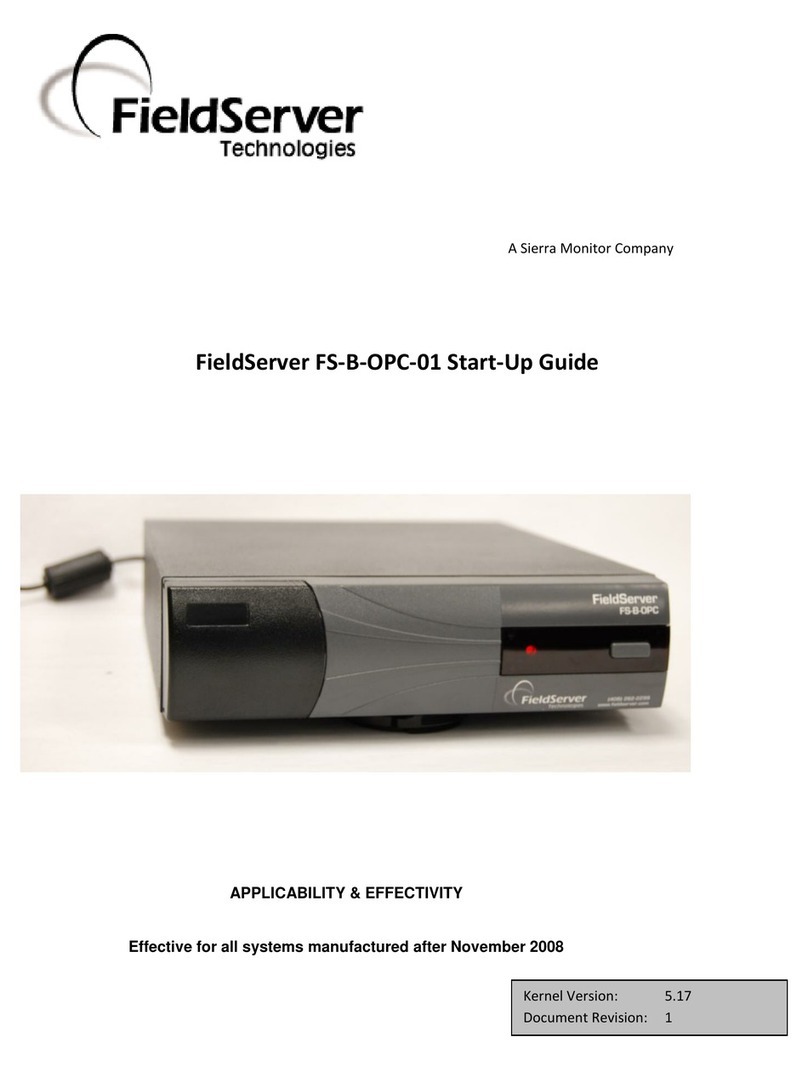
FieldServer
FieldServer FS-B-OPC-01 User guide
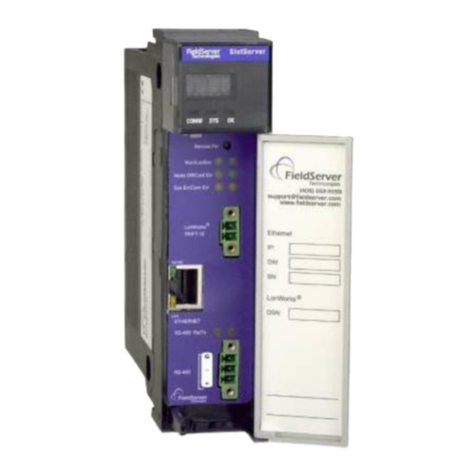
FieldServer
FieldServer SlotServer FS-RA-CLX-BAS User manual
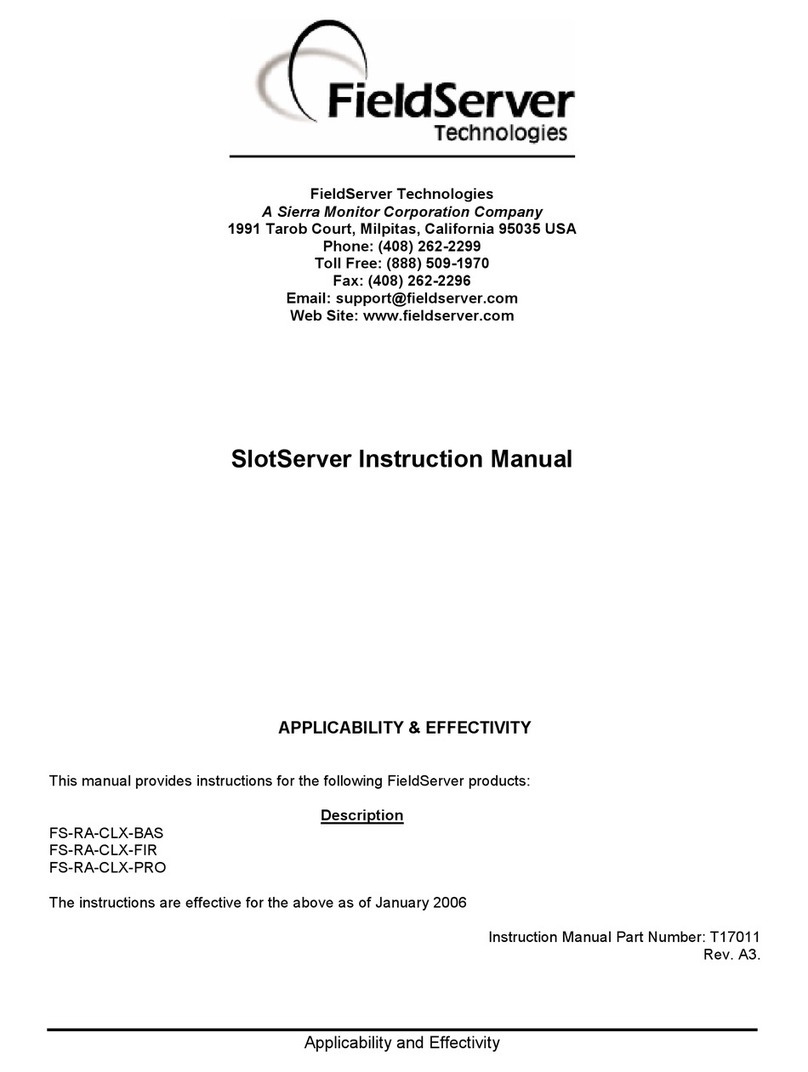
FieldServer
FieldServer FS-RA-CLX-BAS User manual
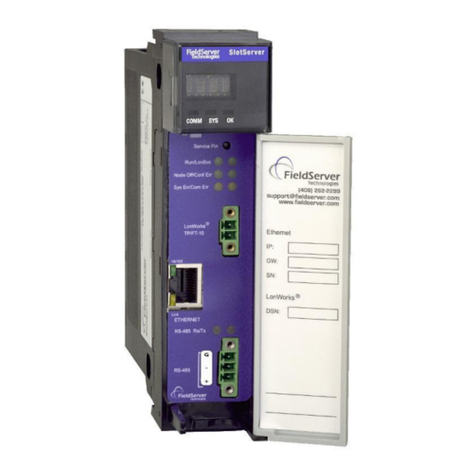
FieldServer
FieldServer SlotServer PS56-BAS Series Instruction sheet
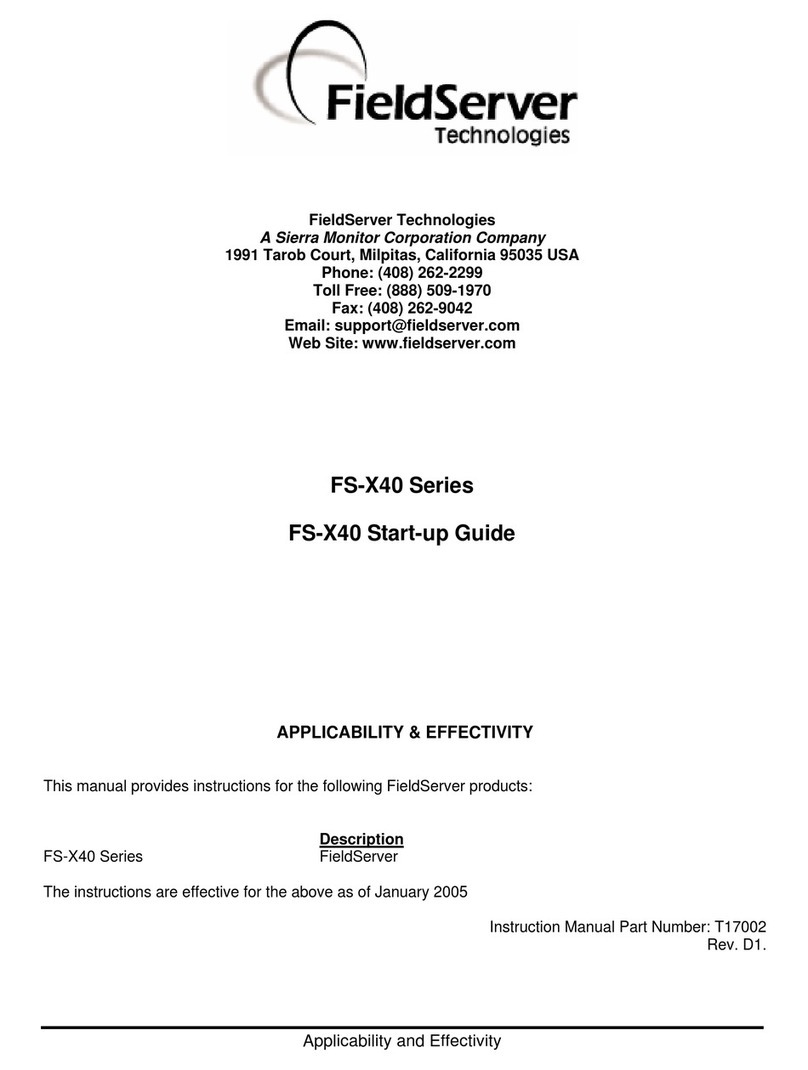
FieldServer
FieldServer FS-X40 User guide

FieldServer
FieldServer PS56-BAS-xxx User guide

FieldServer
FieldServer QuickServer PS-QS-1010 User manual
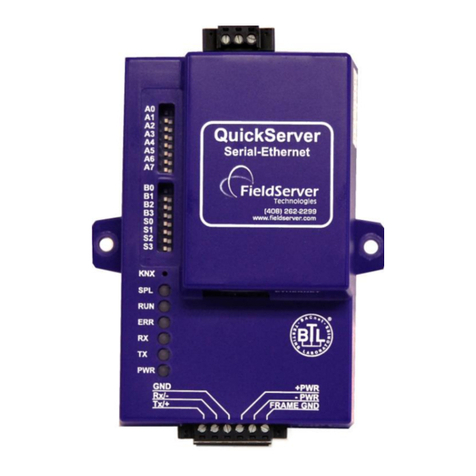
FieldServer
FieldServer QuickServer 12 0 Series User guide

FieldServer
FieldServer FS-X20 Series User guide
